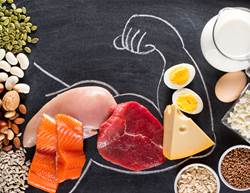If you’re looking to boost your protein intake, pasta might not be the first food that comes to mind. Traditional pasta tends to be higher in carbohydrates, but newer high-protein varieties are changing that narrative. Just to be clear—we’re still fans of regular pasta, but these protein-packed options have earned a spot in our weekly rotation.
Legumes like beans and lentils, along with whole grains, are often responsible for the elevated protein content, says dietitian Maddie Pasquariello.
“Ingredients vary, so protein levels can differ, but usually you’ll get between 10 to 20 grams per 56-gram serving,” adds registered dietitian Melissa Mitri.
A food can be labelled “high protein” if it contains 20% or more of the recommended daily value. Pasquariello explains that the minimum protein requirement is 0.8 grams per kilogram of body weight. However, people who are very active or focused on muscle growth may need closer to two grams per kilogram. So, whether a pasta qualifies as high-protein depends on your individual needs.
That said, it’s still important to enjoy high-protein pasta as part of a balanced diet that includes plenty of vegetables, fruit, healthy fats and other sources of protein, Pasquariello adds. “I wouldn’t rely on protein pasta as your main source of micronutrients during a meal,” she says.
Keen to try it? Our expert-approved picks below are a great way to round out a nourishing lunch or dinner once or twice a week.
The best high-protein pastas
Looking to stock your pantry? Here are some of the top high-protein pasta picks recommended by dietitians.
1. Chickpea Pasta
Chickpea pasta is one of the most accessible high-protein options, made entirely from ground chickpeas. It has a mild, slightly nutty flavour and a firm bite that holds up well after cooking. Naturally high in both protein and fibre, it helps keep you full for longer. It pairs well with tomato-based sauces, pesto or roasted vegetables.
2. Lentil Pasta (Red or Yellow)
Lentil pasta—whether red or yellow—offers a dense texture and a rich, earthy taste. It’s packed with protein and iron, making it especially beneficial for those limiting meat. The flavour stands up well to bold sauces like arrabbiata or curry blends. It also cooks quickly, making it a handy option for weeknight meals.
3. Edamame or Soybean Pasta
Made from green soybeans, edamame pasta is a protein powerhouse with up to 25 grams per serve. It has an earthy flavour and chewy texture, ideal for Asian-inspired dishes or creamy peanut sauces. This type of pasta suits active individuals or those aiming to increase plant-based protein. It holds its shape well and rarely goes mushy.
4. Quinoa-Blended Pasta
Quinoa pasta usually combines quinoa with brown rice or corn to balance protein, fibre and texture. It has a neutral flavour and a softer bite, which works nicely with light sauces or grilled vegetables. It offers a moderate protein boost for those who want more than what traditional pasta provides. It’s also naturally gluten-free.
5. Lupin Flour Pasta
Lupin pasta is made from lupin beans and is high in protein while staying low in carbs. It’s mild in flavour and has a firm texture, making it a favourite for those on low-carb or keto-style eating plans. It works well with Mediterranean-style sauces or veggie-based toppers. It’s a great substitute for wheat pasta without compromising on protein.
6. Black Bean Pasta
Black bean pasta brings a dramatic colour and a mild sweetness to the plate. It’s protein-rich and high in fibre, making it filling and digestion-friendly. Best paired with spiced sauces or sautéed veg, it’s a great base for Latin-inspired meals. Its unique look also adds visual interest to simple dishes.
7. Multi-Legume Pasta
This pasta blends different legumes like lentils, peas and chickpeas for a well-rounded nutritional profile. It usually has a balanced flavour and a more stable texture that holds up in various recipes. With solid levels of protein and fibre, it’s a good everyday option. It adapts well to everything from classic tomato sauces to cold pasta salads.
How to choose protein-rich pasta
When in doubt, go for legumes. Most protein pastas are made from legumes and beans, which generally offer more protein than grain-based or flour-cut varieties, say Mitri and Pasquariello. “Beyond that, pick the brand that best suits the recipe and your taste preferences,” Pasquariello adds.
The bottom line
If you eat pasta regularly, find it hard to reach your protein goals, or simply want a fibre- or protein-rich swap from time to time, high-protein pasta is worth a try. With so many options available, there’s likely one that suits your lifestyle and preferences.
Frequently asked questions
What are the benefits of high-protein pasta?
“Protein plays a key role in muscle repair and bone health,” says Mitri. “It can help boost energy, keep you feeling fuller for longer, reduce cravings, and support weight loss.” The added fibre in many varieties also supports digestive health.
Is high-protein pasta healthy?
High-protein pasta can absolutely be a healthy option, especially for people who don’t eat meat but want to increase their protein intake. That said, variety and balance still matter.
Does high-protein pasta taste good?
Taste is personal, but some brands are closer to traditional pasta than others. “If you don’t enjoy it, I don’t think it’s worth forcing yourself to eat it just for the protein,” says Pasquariello. “I sometimes find that the highest protein options taste less like pasta and can fall apart more easily, so you may want to try something in the middle range.”








.jpg&h=193&w=250&c=1&s=1)
